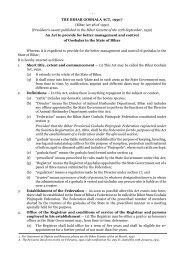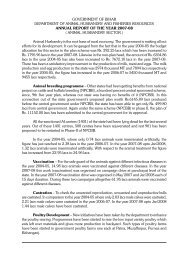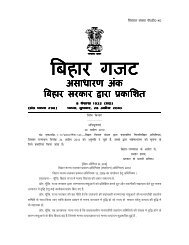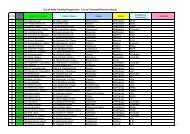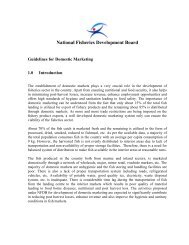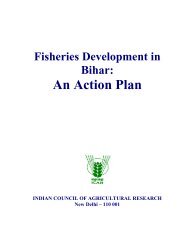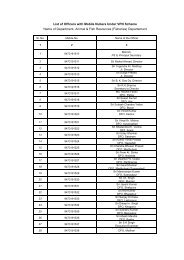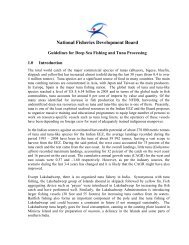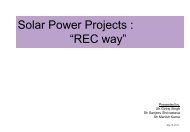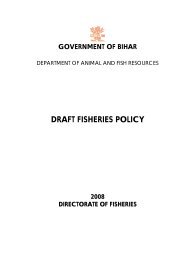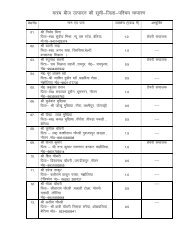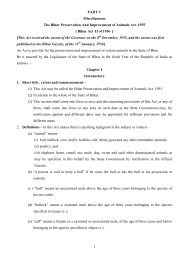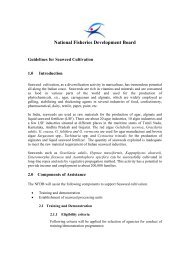National Fisheries Development Board - Animal & Fish Resources
National Fisheries Development Board - Animal & Fish Resources
National Fisheries Development Board - Animal & Fish Resources
You also want an ePaper? Increase the reach of your titles
YUMPU automatically turns print PDFs into web optimized ePapers that Google loves.
<strong>National</strong> <strong><strong>Fish</strong>eries</strong> <strong>Development</strong> <strong>Board</strong>Guidelines for Coastal Aquaculture1.0 IntroductionThe coastal areas of the country are highly amenable for brackish water aquaculture andbased on survey an area of 1.2 to 1.4 million ha has been estimated to be available foraquaculture. Presently, about 150 000 ha is under farming, with tiger shrimp (Penaeusmonodon) as the principal crop. Annually, about 110 – 120 000 metric tonnes of shrimpare harvested, which contribute to about 50 percent of the total shrimp exports from thecountry.<strong>Development</strong> of shrimp farming from a traditional activity to a highly commercialfarming enterprise in a span of about one decade has been one of the most spectacularachievements of aquaculture in India. However, this fast growth of shrimp aquaculture inthe country also raised several social and environmental concerns, leading to interventionof the Supreme Court and establishment of an Authority to regulate the development offarms and farming practices. Subsequently, the Government of India enacted the CoastalAquaculture Authority Act, 2005, enabling the establishment of the Coastal AquacultureAuthority for enforcing proper regulatory measures for carrying out coastal aquaculture ina more sustainable and eco-friendly manner. The Act encompasses all forms ofaquaculture to be practiced in saline or brackish water in the coastal areas but excludesfreshwater aquaculture.While analysing the impacts of shrimp farming on the coastal environment, it was amplyclear that majority of the shrimp farmers lacked the skills to adopt scientific normsessential for brackish water aquaculture. Their awareness levels were inadequate andneither the State Government nor the farmers were geared to meet the challenges thatwere posed by issues such as pollution, viral diseases, etc.With the enactment of the Coastal Aquaculture Authority Act, 2005, substantialexpansion is expected in the coastal aquaculture activities. However, it is also theintention of the Government that in this renewed phase of development of coastalaquaculture, the mistakes committed in the past should not be repeated and thedevelopments should be sustainable and contribute to the well being of the coastalcommunities and the environment.To achieve the above objectives, the <strong>National</strong> <strong><strong>Fish</strong>eries</strong> <strong>Development</strong> <strong>Board</strong> (NFDB) hasallocated funds for training of coastal aquaculture farmers, extension of goodmanagement practices (GMPs) through demonstrations, etc. and strengthening ofinstitutional capacities to undertake human resource development on a regular basis. Pastexperience has shown that motivating the farmers on GMPs and awareness building hasbeen a herculean task and, therefore, concerted efforts would be necessary throughtraining and awareness programmes so that farmers receive adequate training andenhance their skills to practice sustainable coastal aquaculture.
The NFDB’s programmes on coastal aquaculture envisage bringing an additional area of100 000 ha under shrimp aquaculture and another 50 000 ha under finfish farming (seabass, groupers, snappers, mullets, etc.). The <strong>Board</strong> has not allocated any subsidycomponent to support development of coastal farming areas. However, it shall coordinatewith the financial institutions to facilitate investments through Bank finance fordevelopment of coastal aquaculture. The entire funds of Rs 15 crores earmarked forcoastal aquaculture by the NFDB shall be utilized for organizing training anddemonstration programmes to benefit about 100 000 coastal aquaculture farmers.The present guidelines cover the entire range of activities that would be supported fororganization of training and demonstration by the implementing agencies. The objectivesof the guidelines are also to bring in clarity and objectivity, thus facilitating theimplementing agencies in preparation and submission of suitable proposals in tune withthe criterion evolved by the NFDB for providing assistance for development of coastalaquaculture in the country.2.0 Components of AssistanceThe NFDB will assist the component of ‘Training and Demonstration’ to supportdevelopment of coastal aquaculture. In this regard, implementing agencies can submitproposals for conducting the training programmes on adoption of GMP’s in coastalaquaculture such as Shrimp farming, Seabass culture, Grouper culture, Snapper culture,Mullet culture etc.Unit cost (training and demonstration)The unit cost includes a standard training period of ten (10) days and thefollowing activities shall be funded under the programme:(i) Assistance to farmer: The farmer shall be eligible for a daily allowance of Rs125/ day and reimbursement of to and fro travel (train/ bus/ auto rickshaw) shallbe reimbursed as per actuals, subject to a maximum of Rs 500.(ii) Honorarium to resource person: For conduct of training, the implementingagency may engage the services of one resource person per training programme.The resource person may be given an honorarium of Rs 1 250 and to and fro travelexpenses (train/ bus/ auto rickshaw) shall be reimbursed as per actuals, subject toa maximum of Rs 1 000.(iii) Assistance to implementing agencies: The implementing agency shall beeligible to receive Rs 75/ trainee/ day for a maximum period of 10 days fororganizing the training. This cost shall cover expenses towards identification andmobilization of the trainee and course material/ training kits, etc.(iv) <strong>Development</strong> of training/ demonstration site(s):(a) The State Government (Department of <strong><strong>Fish</strong>eries</strong>) shall be eligible to receive aone-time grant of Rs One lakh only (Rs 1 00 000) for development of theirexisting coastal aquaculture farm for undertaking training/ demonstrationprogrammes on a regular basis. The State Government shall not be eligible for anysubsequent grant for the same training site for the same purpose from NFDB orfrom any other funding agency for a period of five (5) years.
(b) In case the State Government does not posses its own facility which can beused for training/ demonstration, it would be eligible to engage a private coastalaquaculture farm for undertaking training/ demonstration and for the purpose anamount of Rs Five thousand only (Rs 5 000) shall be made available for hiring thefacility.Besides the above, the State Government shall also abide by the followingconditions:• The facilities developed by the State Government shall also be available toother implementing agencies for training of coastal aquaculture farmers underthe NFDB programme.• The training/ demonstration facilities developed by the State Government shallnot be more than 25 km from the training site. However, if such a facilitycannot be developed within 25 km, full justification shall be provided.• The NFDB shall not fund any other training/ demonstration site over andabove the one developed to ensure its optimal utilization.• Each training batch shall consist of 25 trainees and in no case exceed 30trainees per batch.• All State/ Union Territory Governments shall be assisted with the setting up ofa maximum of one (1) training/ demonstration site initially per district.Additional site(s) shall only be sanctioned depending upon the performanceand optimal utilization of the site(s) already sanctioned. Establishment ofadditional sites would also be linked to the number of farmers trained, areacovered and institutional finance availed by the trained farmers for taking upaquaculture activities.• All other implementing agencies including <strong><strong>Fish</strong>eries</strong> Institutes under theIndian Council of Agricultural Research and the Colleges of <strong><strong>Fish</strong>eries</strong> underthe State Agricultural University shall avail their own facilities for which alump sum of Rs Five thousand only (Rs 5 000) per training programme shallbe provided. However, if such agencies do not have their own facility, theyshall make use of the facility developed by the State Government or engagethe facility of a private farmer, for which Rs Five thousand only (Rs 5 000) pertraining programme shall be provided.• The State Government shall also train at least one batch of 25 trainees/entrepreneurs each year who shall be exclusively trained in setting up andoperation of hatcheries, especially finfish hatcheries.• The State Government and other Implementing Agencies shall maintain theprofile of each trainee and provide information on the area farmed by eachtrained farmer, investments made, employment generated and increase inproduction and productivity. The consolidated information on the above shallbe made available to NFDB at quarterly intervals for a period of five years.
• The State Government shall also be responsible for facilitating institutionalfinance to the coastal aquaculture farmers.• The Implementing Agency and the NFDB shall enter into an MOU prior torelease of funds for training and demonstration. The conditions stipulated inthe Guidelines shall inter alia be a part of the MOU.3.0 Submission of ProposalsAll proposals shall be submitted by the Implementing Agencies at the beginning of eachquarter (i.e. April, July, October, January) to the NFDB for approval and release of funds.To ensure uniformity in the details provided by the Implementing Agencies, applicationshall be submitted in the forms (Form – CA - I) attached to the guidelines:4.0 Release of fundsThe grant for Training and Demonstration shall be released in a single installment, onapproval of the proposal by the NFDB.5.0 Submission of Utilisation CertificateThe Implementing Agencies shall submit utilization certificates in respect of the fundsreleased to them by the <strong>Board</strong>. Such certificates shall be submitted in Form- CA- II onhalf-yearly basis i.e. during July and January of each year.6.0 Monitoring and EvaluationThe State Governments shall set up a dedicated Monitoring and Evaluation Cell (M & E)in the Department of <strong><strong>Fish</strong>eries</strong> to periodically monitor and evaluate the progress ofactivities implemented under the NFDB funding. The Cell may be set up under thechairpersonship of the Secretary In-charge of <strong><strong>Fish</strong>eries</strong> and may include representativesof the State Departments of Finance and <strong><strong>Fish</strong>eries</strong> and representatives of FFDA andCommercial Bank/ NABARD. The M & E Cell shall also establish financial and physicaltargets in consultation with the NFDB against which the performance and utilisation offunds shall be monitored.
FORM – CA - IApplication for submission of proposal for financial assistance from<strong>National</strong> <strong><strong>Fish</strong>eries</strong> <strong>Development</strong> <strong>Board</strong>Proposal for Training and Demonstration in Coastal AquacultureSl. Particulars sought from the Implementing Information furnished by theNoAgencyImplementing Agency(1) (2) (3)1.0 Name of the training programme1.1 Name and address of the Implementing Agency:2.0 Location of the Training Facility:District Block Village3.0 Facilities available or proposed for impartingtraining:4.0 Details of the Training Programme:a) Number of persons to be trained in coastalaquaculture and in hatchery operations (tobe given separately):b) Of which number of existing coastalaquaculture farmers:c) Farmers having their own ponds/ tanks toundertake coastal aquaculture:5.0 Area under coastal aquaculture/ expected toincrease after training programme:a) Existing area under coastal aquaculture(ha):b) New area to be developed by the trainedfarmers (ha):5.0 Average production of shrimps/fish/othersspecies in the area (kg/ ha/ annum):6.0 Whether the demonstration site would be in theFarm of the State Government or will be takenup in farm on lease basis:7.0 If demonstration site other than the farm of theDepartment of <strong><strong>Fish</strong>eries</strong>, please provide thefollowing details:a) Complete address of the farm:b) Size of the ponds (ha):c) Distance from the location of the trainingsite:
(1) (2) (3)8.0 Whether the Implementing Agency proposes toengage farmer’s pond? If so, the number oftraining programmes to be conducted in a yearmay be indicated:9.0 Financial Implications:Item Number Amounta) Training(i) Assistance to farmer @ Rs 125/ day for10 days:(ii) Reimbursement of to and fro travelexpenses to farmer:(iv) Assistance to implementing agency @Rs 75/ trainee/ day:(iii) Honorarium to resource persons andreimbursement of to and fro travelexpenses:Total of (a)b) Demonstration UnitGrand Total (a + b)10.0 Technical capabilities of resource persons to beengaged in training:11.0 Any other details in support of the proposalDate:Place:Signature and seal of the authorizedrepresentative of the ImplementingAgency
FORM – CA - II<strong>National</strong> <strong><strong>Fish</strong>eries</strong> <strong>Development</strong> <strong>Board</strong>Form for Submission of Utilization CertificateSl. No Letter No and date Amount Certified that out of Rs _____________sanctioned during the year___________in favour of ____________ under the<strong>National</strong> <strong><strong>Fish</strong>eries</strong> <strong>Development</strong> <strong>Board</strong>’sLetter No given in the margin and Rs_____________ on account of unspentbalance of the previous sanction, a sumof Rs ___________ has been utilized forthe purpose of____________ for whichit was sanctioned and that the balance ofRs ___________ remains unutilized.The same will be adjusted towards thenext installment payable during theperiod________.2.0 Certified that I have satisfied myself that the conditions on which the funds weresanctioned by the <strong>National</strong> <strong><strong>Fish</strong>eries</strong> <strong>Development</strong> <strong>Board</strong> have been duly fulfilled/are being fulfilled and that I have exercised the following checks to see that themoney was actually utilized for the purpose for which it was sanctioned.Date:Place:Signature and seal of theauthorized representative of theImplementing Agency



